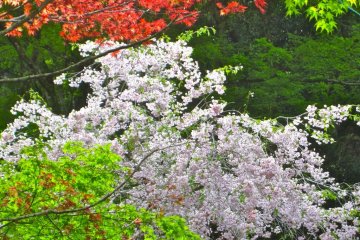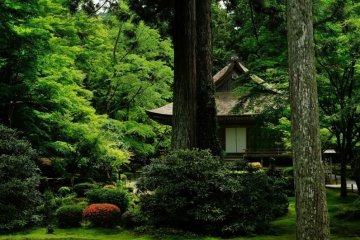
ศาลเจ้าคิบุเนะ เหนือเกียวโต
Bryan Baierศาลเจ้าเล็ก ๆ แต่สวยงามมากและผู้คนบางตา อยู่ในภูเขาทางทิศเหนือเกียวโต

Kifune Shrine, nestled in the picturesque mountain town of Kibune, is said to be over 1,300 years old and is dedicated to the god of water. The complex has three shrine buildings along the mountainside: the main shrine (front shrine), Yui no Yashiro (middle shrine), and Okunomiya (rear shrine). A common pilgrimage path is to visit the main shrine first and then go to the rear one, before ending your journey at the middle shrine.
One of the shrine’s most notable features is its lantern-lined stone steps. The brilliant coloring of the red lanterns compliments the surrounding nature during all seasons—whether it's the verdant foliage of spring and summer, the fiery leaves of autumn, or the pure-white snow of winter. No matter the season, the ascension to the shrine is always a magical one.
The first and main shrine building has a modest wooden facade with sparse gold accents that perfectly reflect the encircling forests. Located in front of the building is a stone wall with a small fountain of sacred water (goshinsui) where you can have a sip of the crisp mountain water. The shrine also offers a unique form of fortune telling called mizuura mikuji. After you purchase the fortune telling sheet, place the paper in a fountain near the shrine. As the water seeps through the paper, it will reveal your fortune!
The middle shrine (Yui no Yashiro) is smaller in size and is known as a shrine for love. Legend has it that Ninigi no Mikoto, great grandfather to Emperor Jinmu, did not receive the hand of the woman he wished to marry. As a result, he proclaimed that he would remain at the temple and bless people with good relationships.
The last shrine (Okunomiya) is the location of the original main shrine before it was flooded in the 11th century. According to the legend of Kibune’s founding, a goddess landed at the area that is today Okunomiya on a holy boat. The stones to the left of the shrine are said to contain the goddess’s boat. The shrine is also built over what is said to be a ryuuketsu, or a dragon’s den. The ryuuketsu, coupled with the sacred boat, make the area a spiritual power spot.
Take the Keihan Train Line to Demachiyanagi Station and then transfer to the Eizan Train Line. Get off at Kibune-guchi Station. From the station, take Kyoto Bus Route 33 to Kibune Bus Stop. Then, walk about 5 minutes to Kifune Shrine.

ศาลเจ้าเล็ก ๆ แต่สวยงามมากและผู้คนบางตา อยู่ในภูเขาทางทิศเหนือเกียวโต

Kifune Club คาเฟ่เรือนไม้แสนเท่ท่ามกลางป่าอันเขียวขจีของคิบุเนะ เกียวโต กับกาแฟแสนอร่อยและขนมหวานที่ยอดเยี่ยมอย่าบอกใคร

LOVES BAGEL (Kyoto) เบเกิ้ลร้อนๆ ... เสิร์ฟด้วยรัก

MAMEZEN SOBA (豆禅) ราเม็งเกียวโตสูตรน้ำเต้าหู้ อร่อยถึงเครื่อง สไตล์เบาๆ

Sanzen-in is a Tendai school monzeki temple in Ōhara, Kyoto, Japan. The Heian period triad of Amida Nyorai flanked by attendants is a National Treasure. Sanzenin Temple is the main attraction of the rural town of Ohara, which is located about an hour north of central Kyoto. [Wikipedia]

The Kamo Shrines, Shimogamo Shrine and Kamigamo Shrine are both recognized as UNESCO World Heritage Sites. They are two of the most important and oldest shrines in Kyoto. They are located in the north of the city and are intentionally placed to ward off evil and Protect the city In fact, the two Kamo shrines are even older than the city, which became the national capital in 794. Shimogamo Shrine is located at the confluence of the Takano and Kamo Rivers and is surrounded by a forest that contains trees up to 600 years old. The Kamigamo Shrine is about three and a half kilometers upstream and is known for two sand cones on its site, which have a cleaning function for the sanctuary and have been ritually made since ancient times. Together the shrines host one of Kyoto's three biggest festivals, the Aoi Matsuri, which takes place on May 15th.

Shugakuin Imperial Villa, located on the northeastern outskirts of Kyoto City, is a stunning complex of traditionally designed buildings and gardens interwoven into paddy fields. It was constructed from 1655 to 1659 by Emperor Gomizuno and presently, is managed by the Imperial Household Agency. The complex features three sections–the Upper, Middle, and Lower Villas–which are connected by tree-lined pathways. Between the villas, the majority of the land is designated as paddy fields and is still cultivated by local farmers today. The most celebrated characteristic of the villa is its gardens. Each section has its own exquisite landscaping that utilizes the Shakkei method of gardening. This process integrates the surrounding scenery into the garden’s design for a more dynamic and three-dimensional viewing experience. The gardens are especially popular in spring when the cherry blossoms and seasonal flowers are in full bloom, and in autumn when the surrounding mountainscape turns fiery. The Upper Villa’s Rin’untei Pavilion is also a noteworthy spot as it offers lovely views of Yokuryūchi pond, Kyoto City, and surrounding naturescape. Although you cannot enter buildings, some are left open so you can have a peek at their tatami floors and beautifully painted panels. In order to enter the villa, you must submit an application and join a guided tour. You can register online or in person. Make sure to have your passport or a government-issued ID on hand. Same day registration is permitted but is run on a first-come-first-served basis. The tour lasts about an hour and 20 minutes and includes visits to all three villas. Although the tour is only available in Japanese, the facility offers audio guides in English, Chinese, French, Korean, and Spanish free of charge.